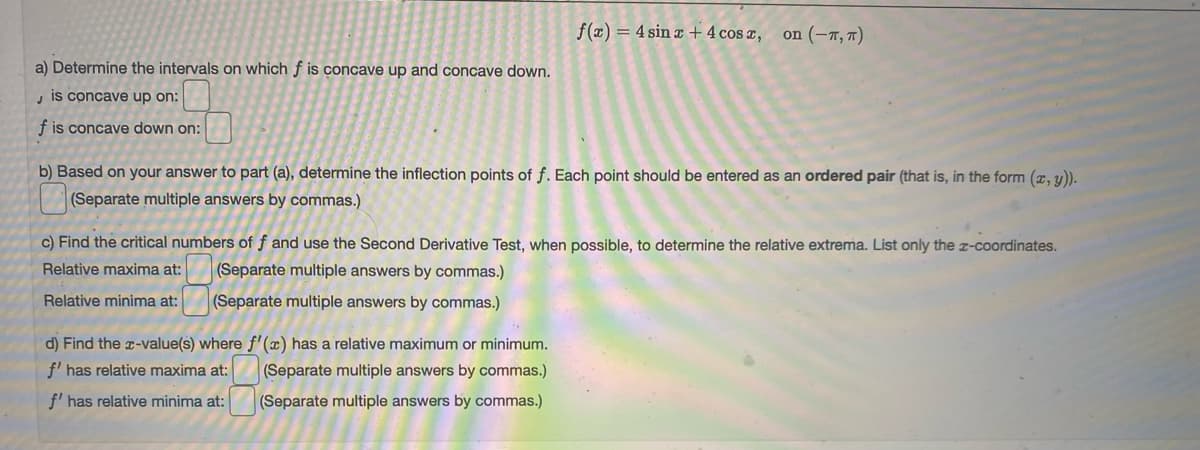- answer to part (a), determine the inflection points of f. Each point should be entered as an ordered pair (th ultiple answers by commas.) al numbers of f and use the Second Derivative Test, when possible, to determine the relative extrema. List on at: (Separate multiple answers by commas.) at: (Separate multiple answers by commas.) luels) where f'(x) has a relative maximum or minimum.
- answer to part (a), determine the inflection points of f. Each point should be entered as an ordered pair (th ultiple answers by commas.) al numbers of f and use the Second Derivative Test, when possible, to determine the relative extrema. List on at: (Separate multiple answers by commas.) at: (Separate multiple answers by commas.) luels) where f'(x) has a relative maximum or minimum.
Algebra & Trigonometry with Analytic Geometry
13th Edition
ISBN:9781133382119
Author:Swokowski
Publisher:Swokowski
Chapter5: Inverse, Exponential, And Logarithmic Functions
Section5.1: Inverse Functions
Problem 18E
Related questions
Question

Transcribed Image Text:f(x) = 4 sin x +4 cos ¤,
on (-7, 7)
a) Determine the intervals on which ƒ is concave up and concave down.
is concave up on:
f is concave down on:
b) Based on your answer to part (a), determine the inflection points of f. Each point should be entered as an ordered pair (that is, in the form (x, y)).
(Separate multiple answers by commas.)
c) Find the critical numbers of f and use the Second Derivative Test, when possible, to determine the relative extrema. List only the z-coordinates.
Relative maxima at:
(Separate multiple answers by commas.)
Relative minima at:
(Separate multiple answers by commas.)
d) Find the r-value(s) where f'(x) has a relative maximum or minimum.
f' has relative maxima at:
(Separate multiple answers by commas.)
f' has relative minima at:
(Separate multiple answers by commas.)
Expert Solution
This question has been solved!
Explore an expertly crafted, step-by-step solution for a thorough understanding of key concepts.
Step by step
Solved in 3 steps with 3 images

Recommended textbooks for you

Algebra & Trigonometry with Analytic Geometry
Algebra
ISBN:
9781133382119
Author:
Swokowski
Publisher:
Cengage


Algebra & Trigonometry with Analytic Geometry
Algebra
ISBN:
9781133382119
Author:
Swokowski
Publisher:
Cengage
